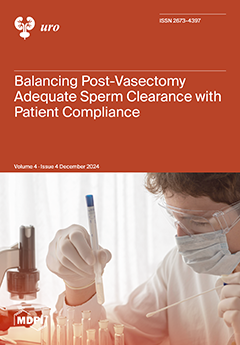Background: Penile squamous cell carcinoma is an aggressive malignancy with significant physical and psychological impacts. Socioeconomic factors influence prognosis in genitourinary cancers, making the investigation of insurance status critical for reducing cancer burden and promoting health equity.
Materials and Methods: Men diagnosed with
[...] Read more.
Background: Penile squamous cell carcinoma is an aggressive malignancy with significant physical and psychological impacts. Socioeconomic factors influence prognosis in genitourinary cancers, making the investigation of insurance status critical for reducing cancer burden and promoting health equity.
Materials and Methods: Men diagnosed with primary penile squamous cell carcinoma from 2007 to 2015 were identified from the Surveillance, Epidemiology, and End Results (SEER) national database. Participants were categorized based on insurance status: privately insured, Medicaid, and uninsured. Pearson’s chi-squared test assessed the distribution of observed frequencies between the patient demographics, socioeconomic status, tumor characteristics, and surgical variables across the insurance groups. Overall and cancer-specific survival was estimated using a multivariate Cox hazards proportional model analysis.
Results: The multivariate Cox hazards proportional model showed that, compared to privately insured patients, Medicaid patients had an increased risk for overall death (hazard ratio [HR] = HR 1.54; 95% CI, 1.12–2.07). For cancer-specific mortality, Medicaid patients had an increased risk of death compared to privately insured patients (HR 1.58; 95% CI, 1.11–2.25).
Conclusions: Medicaid does not mitigate the differences caused by health insurance status due to health insurance disparities for overall or cancer-specific mortality. Lower Medicaid reimbursements and out-of-pocket costs lead to a narrow network of physicians, hospitals, and treatment modalities that compromise health equity. Increasing awareness of health insurance disparities and improving access to care via a clinician–community–governmental partnership can potentially lead to improved predictive outcomes.
Full article



